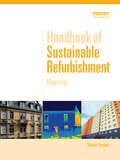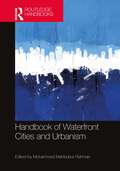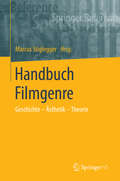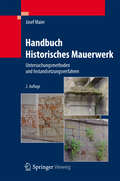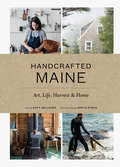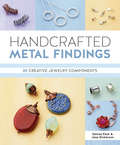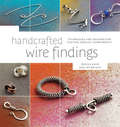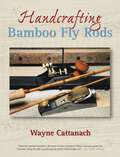- Table View
- List View
Handbook of Standards and Guidelines in Ergonomics and Human Factors
by Waldema KarwowskiA comprehensive review of international and national standards and guidelines, this handbook consists of 32 chapters divided into nine sections that cover standardization efforts, anthropometry and working postures, designing manual material, human-computer interaction, occupational health and safety, legal protection, military human factor standar
Handbook of Sustainable Refurbishment: Housing
by Simon BurtonBased on careful analysis and experience in all housing sectors and house types, this handbook explains and demonstrates how to incorporate the most effective energy saving measures in the existing housing stock.It begins by setting out the basic aims of sustainable refurbishment before presenting a large number of illustrated case studies from a range of single- and multi-family dwellings. A practical section then details the specific measures that can be taken to reduce the energy demand of buildings, with extensive references to further resources. Written for architects and building engineers, the book combines technical and managerial solutions demonstrating that a new refurbishment culture needs to be created that radically improves the energy performance of all existing houses whenever any opportunity presents itself and whenever any work is carried out.
Handbook of Textile and Apparel Costing
by R. Rathinamoorthy R. Surjit K. J. VardhiniHandbook of Textile and Apparel Costing covers a wider area of the costing aspects of industrial and academic requirements from spinning to the apparel sector.It is a one of its kind in the textile and fashion discipline that covers the cost calculation methods of every manufacturing step in entirety: spinning, weaving, processing, and apparel manufacturing.Print edition not for sale in South Asia (Bangladesh, Bhutan, India, Nepal, Pakistan and Sri Lanka)
Handbook of Usability and User-Experience: Methods and Techniques
by Marcelo M. Soares, Francisco Rebelo and Tareq Z. AhramHandbook of Usability and User Experience: Methods and Techniques is concerned with emerging usability and user experience in design concepts, theories and applications of human factors knowledge focusing on the discovery, design and understanding of human interaction and usability issues with products and systems for their improvement. This volume presents methods and techniques to design products, systems and environments with good usability, accessibility and user satisfaction. It introduces the concepts of usability and its association with user experience, and discusses methods and models for usability and UX. It also introduces relevant cognitive, cultural, social and experiential individual differences, which are essential for understanding, measuring and utilizing these differences in the study of usability and interaction design. In addition, the book discusses the use of usability assessment to improve healthcare, the relationship between usability and user experience in the built environment, the state-of-the-art review of usability and UX in the digital world, usability and UX in the current context, and emerging technologies. We hope that this first of two volumes will be helpful to a large number of professionals, students and practitioners who strive to incorporate usability and user experience principles and knowledge in a variety of applications. We trust that the knowledge presented in this volume will ultimately lead to an increased appreciation of the benefits of usability and incorporate the principles of usability and user experience knowledge to improve the quality, effectiveness and efficiency of consumer products, systems and environments in which we live.
Handbook of Usability and User-Experience: Research and Case Studies
by Marcelo M. Soares, Francisco Rebelo and Tareq Z. AhramThis volume of the Handbook of Usability and User Experience (UX) presents research and case studies used to design products, systems and environments with good usability and consequent acceptance, pleasure in use, good user experience, and understanding of human interaction issues with products and systems for their improvement. The book presents concepts and perspectives of UX; it also discusses methods and tools that use requirements analysis activity elicitation, recording, and analysis to guarantee a good user experience. In addition, it introduces usability and UX in the automotive industry, usability and UX in a digital interface, game design and digital media, usability and UX in fashion design, and some case studies on usability and UX in various contexts in product design. We hope that this second volume will be helpful to a larger number of professionals, students and practitioners who strive to incorporate usability and UX principles and knowledge in a variety of applications. We trust that the knowledge presented in this volume will ultimately lead to an increased appreciation of the benefits of usability and incorporate the principles of usability and UX knowledge to improve the quality, effectiveness, and efficiency of everyday consumer products, systems, and environments.
Handbook of Variational Methods for Nonlinear Geometric Data
by Philipp Grohs Martin Holler Andreas WeinmannThis book covers different, current research directions in the context of variational methods for non-linear geometric data. Each chapter is authored by leading experts in the respective discipline and provides an introduction, an overview and a description of the current state of the art. Non-linear geometric data arises in various applications in science and engineering. Examples of nonlinear data spaces are diverse and include, for instance, nonlinear spaces of matrices, spaces of curves, shapes as well as manifolds of probability measures. Applications can be found in biology, medicine, product engineering, geography and computer vision for instance. Variational methods on the other hand have evolved to being amongst the most powerful tools for applied mathematics. They involve techniques from various branches of mathematics such as statistics, modeling, optimization, numerical mathematics and analysis. The vast majority of research on variational methods, however, is focused on data in linear spaces. Variational methods for non-linear data is currently an emerging research topic. As a result, and since such methods involve various branches of mathematics, there is a plethora of different, recent approaches dealing with different aspects of variational methods for nonlinear geometric data. Research results are rather scattered and appear in journals of different mathematical communities. The main purpose of the book is to account for that by providing, for the first time, a comprehensive collection of different research directions and existing approaches in this context. It is organized in a way that leading researchers from the different fields provide an introductory overview of recent research directions in their respective discipline. As such, the book is a unique reference work for both newcomers in the field of variational methods for non-linear geometric data, as well as for established experts that aim at to exploit new research directions or collaborations.Chapter 9 of this book is available open access under a CC BY 4.0 license at link.springer.com.
Handbook of Waterfront Cities and Urbanism
by Mohammed Mahbubur RahmanHandbook of Waterfront Cities and Urbanism is the first resource to address cities’ transformations of their coastlines and riverbanks and the resulting effects on environment, culture, and identity in a genuinely global context. Spanning cities from Gdańsk to Georgetown, this reference for design, development, and planning explores the transition of waterfronts from industrial and port zones to crowd-drawing urban spectacles within the frameworks of urban development, economics, ecology, governance, globalization, preservation, and sustainability. A collection of contextual studies, local perspectives, project reviews, and analyses of evolution and emerging trends provides critical insight into the phenomenon of waterfront development and urbanism in cities from the East to the West. Features: Explores the transformation of waterfronts from industrial hubs to urban playgrounds through the lenses of preservation, governance, economics, ecology, and more. Presents chapter-length case studies drawn from cities in China, Bangladesh, Turkey, the United States, Malaysia, the European Union, Egypt, and other countries. Includes contributions from an interdisciplinary team of international scholars and professionals, a much-needed corrective to the historical exclusion of researchers and issues from the Global South. An ideal reference for graduate students, scholars, and professionals in urban planning, architecture, geography, and history, the Handbook of Waterfront Cities and Urbanism deserves to be on the shelf of urban authorities and any internationally minded academic or practitioner in real estate development, water management, preservation, or tourism.
Handbuch Brettspiele: Tätigkeiten und Akteure in der Brettspielbranche
by Jürgen Karla Christoph PostIm Rahmen einer Podcast-Reihe im Jahr 2021 wurde die Entstehung eines Brettspiels - Von der Idee zum fertigen Produkt betrachtet. Im Rahmen dieses Herausgeberbandes erfolgt nun eine schriftliche Dokumentation durch Expertinnen und Experten aus der Brettspielbranche. Einleitend erfolgt eine Darstellung der Branche und der Branchenstrukturen orientiert an den Netzwerkstrukturen moderner Wertschöpfung. Bekannte Autorinnen und Autoren erläutern Ihre Vorgehensweisen zur Entwicklung von Brettspiel-Ideen und deren Weiterleitung an die Redaktionen in Verlagen. Führende Experten aus verschiedensten Aufgabengebieten in Verlagen stellen Ihre Aufgabenbereiche vor und erläutern die Prozesse in der Entstehung von Brettspielen (Redaktion, Illustration, Grafik, Lokalisierung, Lizenzierung). Der Produktionsprozess wird ausgehend von der Kalkulation, über den Einkauf, unterschiedliche Materialkomponenten, die Produktionsstätten bis zu Qualitätssicherung und Produktsicherheit. Unterschiedliche Vertriebswege für Brettspiele werden ebenso betrachtet wie die Medien- und Kommunikationsarbeit in Verlagen. Es erfolgt eine Betrachtung der verschiedenen Mediensegmente, über die Inhalte mit Brettspiel-Bezug rezipiert werden, sowie eine Betrachtung der für die Branche relevanten Auszeichnungen. Der Betrachtung des Kulturguts Brettspiel aus verschiedenen Blickwinkeln ist die abschließende Sektion dieses Buches gewidmet. Das Handbuch ist nicht nur für Brancheninsider von Interesse, sondern auch für Brettspielfans, die einen tieferen Einblick in das Hobby gewinnen möchten.
Handbuch Energieeffizienz im Quartier: Clever versorgen, umbauen, aktivieren
by Christa Reicher Anke SchmidtIm Rahmen des Fortschrittskollegs Energieeffizienz im Quartier wurde das Thema von 11 DoktorandInnen unterschiedlicher Disziplinen untersucht. In den Arbeiten werden Lösungsansätze und Empfehlungen für Akteure der Energiewende entwickelt.
Handbuch Filmanalyse (Springer Reference Geisteswissenschaften Ser.)
by Malte Hagener Volker PantenburgBewegte Bilder begegnen uns heute jederzeit und überall – umso wichtiger ist es, die filmwissenschaftlichen Erkenntnisse auf dem Gebiet der Filmanalyse zu sammeln, zu systematisieren und kritisch zu evaluieren. Dieses Handbuch erschließt das Feld in ca. 30 Beiträgen auf dem aktuellen Stand der Ansätze, Praktiken und Debatten.
Handbuch Filmgenre: Geschichte – Ästhetik – Theorie (Springer Reference Geisteswissenschaften Ser.)
by Marcus StigleggerDas vorliegende Handbuch bietet einen umfassenden Überblick über den Stand der Filmgenreforschung. Es werden sowohl die Definitionen und die Begriffsgeschichte umfassend dargestellt, verschiedene Theorien und Ansätze, historische und lokale Perspektiven vorgestellt, als auch einzelne Filmgenres wie Western, Kriminalfilm, Gangsterfilm, Thriller, Science Fiction, Horror, Fantasy, Komödie, Melodram, Abenteuerfilm, Musical, Kriegsfilm bis hin zum erotischen Film in Einzelstudien analysiert.In dieser Multiperspektivik bildet der Band die Phänomenologie von Filmgenres quer durch die Filmgeschichte als einen umfassenden Diskurs ab, der durch Beiträge von führenden Vertreterinnen und Vertretern der deutschsprachigen Genreforschung nah an internationalen Filmbeispielen diskutiert wird.
Handbuch Filmsoziologie
by Alexander Geimer Rainer Winter Carsten HeinzeDer Band greift filmsoziologische Fragestellungen in ihren vielfältigen Facetten auf, die von renommierten Wissenschaftler*innen bearbeitet werden. In Überblicksartikeln wird ein Einblick in die zentralen Themenfelder eröffnet. Im ersten Kapitel werden historische Wurzeln und Traditionen am Beispiel bedeutender Filmsoziolog*innen dargestellt und so ein historischer Abriss zu Themen und Problemen der Filmsoziologie gegeben. Im zweiten Kapitel werden theoretische Perspektiven der Filmsoziologie behandelt, im dritten Kapitel verschiedene Methodologien vorgestellt. Das vierte Kapitel beschäftigt sich mit einzelnen Themen des Films und Genreanalysen. Das fünfte Kapitel widmet sich in Abgrenzung zum fiktionalen Film dem dokumentarischen Film in Theorie und Geschichte. Das sechste Kapitel stellt aktuelle Bezugsfelder der Filmsoziologie dar und öffnet Perspektiven für den interdisziplinären Austausch.
Handbuch Filmtheorie (Springer Reference Geisteswissenschaften Ser.)
by Bernhard Groß Thomas MorschDas erste Handbuch zur Filmtheorie im deutschsprachigen Raum stellt in fundierten, aktuellen und von ausgewiesenen Fachleuten verfassten Artikeln zentrale Paradigmen, Grundlagen, Konzepte und methodische Ansätze der Filmtheorie vor. In ausführlichen und selbständigen Artikeln gibt das Handbuch einen Überblick über Themen und Debatten der Filmtheorie und arbeitet ihre Aktualität heraus. Es vermittelt einen umfassenden und systematischen Einblick in die Fachdiskussion und ihre interdisziplinäre Vernetzung.
Handbuch Historisches Mauerwerk
by Josef MaierDas Buch bietet einen umfassenden Überblick zu Schäden am historischen Mauerwerk: nicht nur Feuchtigkeits- und Salzschäden, sondern auch Schäden durch Risse und lose Füllschichten. Der Autor liefert wertvolle Tipps zur Erkennung der Schadensursachen sowie Anleitungen für zerstörungsarme Untersuchungen und für die Instandsetzung. In die 2. Auflage wurden neue technische Möglichkeiten zur Instandsetzung von historischem Mauerwerk aufgenommen, aktuelle Normen und Regelwerke sowie neue Anforderungen zum Schall- und Wärmeschutz wurden berücksichtigt.
Handbuch Nachhaltige Energiesysteme im Quartier: Modelle und Strategien zwischen lokalen und globalen Herausforderungen
by Christa Reicher Canan Çelik Eva Christine Hahn Antonia RubarthDie NRW Forschungskollegs sind mit anwendungsbezogener Forschung auf Themenfeldern von hoher gesellschaftspolitischer Relevanz befasst. Kennzeichnend für ihre Forschungsansätze ist eine hohe Komplexität. Durch die Anwendung von inter- und transdisziplinären Forschungsmethoden werden ausgewogene und umsetzbare Lösungsansätze erwartet. In den Kollegs sollen entsprechende Forschungsmethoden vermittelt und weiterentwickelt werden.Das Forschungskolleg NRW „Nachhaltige Energiesysteme im Quartier“ hat zum Ziel, technische, wirtschaftliche und soziale Steuerungsmodelle zur Steigerung der Energieeffizienz im Quartier zu entwickeln. Damit leistet das Forschungskolleg mit seiner breiten interdisziplinären Zusammensetzung und Einbettung in die Praxis (transdisziplinär) einen wichtigen Beitrag, um integrierte Konzepte zu entwickeln und die notwendige Verständigung zwischen den Disziplinen sowie zwischen zukünftigen Wissenschaftlerinnen und Wissenschaftlern mit Praktikerinnen und Praktikern zu fördern. Konkrete Handlungsmöglichkeiten und Optionen sollen die handelnden Parteien, allen voran Stadtwerke, Kommunen, Politik und Bürger darin unterstützen, die Energiewende im Quartier voranzutreiben. Das komplexe Thema der nachhaltigen Energiesysteme ist gekoppelt mit den Herausforderungen Klimawandel, demografische Entwicklung, Transformation der Energieversorgung sowie der Wärme- und Mobilitätswende. Hierzu reicht es nicht aus den Stromsektor zu betrachten, da auch der Wärmesektor und die Mobilität ein großes Potenzial zur Minderung von CO2-Emissionen aufweisen. Für diese drei wichtigen Sektoren einerseits und für die Betrachtung der handelnden und konsumierenden Akteure andererseits ist das Quartier eine geeignete räumliche Bezugsgröße. Der räumliche Fokus der Forschungsarbeiten liegt neben dem Ruhrgebiet und dort ausgewählten Quartieren auch auf dem Rheinischen Revier.
Handbuch der Sportphotographie
by Cristiano Pugno Pia-Felicitas HawleDieses Handbuch richtet sich an all jene, welche sich auf die Sportphotographie spezialisieren wollen. Das Handbuch eignet sich für Anfänger wie auch für fortgeschrittene Photographen, die Empfehlungen eines erfahrenen Kollegen wertschätzen, Photographen, die für sich selbst oder aber auch für Magazine, Tageszeitungen oder Photoagenturen tätig sind. Das Buch gliedert sich in drei Teile und diskutiert die verschiedensten Sportarten, beim Fußball angefangen, über den Laufsport, Hallensportarten und schließlich die Wassersportarten.
Handbuch der Sportphotographie
by Cristiano Pugno Pia-Felicitas HawleDieses Handbuch richtet sich an all jene, welche sich auf die Sportphotographie spezialisieren wollen. Das Handbuch eignet sich für Anfänger wie auch für fortgeschrittene Photographen, die Empfehlungen eines erfahrenen Kollegen wertschätzen, Photographen, die für sich selbst oder aber auch für Magazine, Tageszeitungen oder Photoagenturen tätig sind. Das Buch gliedert sich in drei Teile und diskutiert die verschiedensten Sportarten, beim Fußball angefangen, über den Laufsport, Hallensportarten und schließlich die Wassersportarten.
Handbuilt: A Modern Potter's Guide to Handbuilding with Clay
by Lilly MaetzigCreate a collection of 23 stylish homewares with this modern guide to working with clay. Covering the oldest and most traditional ways to make pots, Handbuilt is a beginner's guide to hand building with clay – no pottery wheel required. This book will teach you the building blocks to working with clay and how to apply a professional finish to your pots including decoration, glazing and firing techniques. Learn how to create a collection of 22 stylish homeware designs using the three core techniques: coiling, pinching and slab building. Beginning with the basics to get you started, discover how to wedge clay, add texture and work with moulds, then put your new skills to the test through the projects that include coffee cups, a tea pot, vase, dinner plates, candle holders and more. Packed with stunning lifestyle photography to help inspire your own handmade journey alongside clear step-by-steps and Lilly's expert tips will lead you through the process, Handbuilt is the ultimate modern guide this popular, tactile and ancient craft.
Handcrafted Bicycles: Builders, Frame Design, and Inspiration
by Christine Elliott David JablonkaHandcrafted Bicycles: Builders, Frame Design, and Inspiration celebrates the artistry of bicycle building, revealing that bicycles are so much more than a set of handlebars, a seat, a frame, wheels, a chain, and pedals. Bicycles are about the builder, the rider, the ride, riders&’ needs, special componentry, and aesthetics. This stunning coffee-table book showcases 32 exceptional bicycle builders from 13 countries, capturing their unique designs and the stories that inspire them. Designers include both established and contemporary bike builders who find themselves in demand for an ever expanding cycling culture. Key Features: • 32 Chapters on different bicycle designers: Each featuring striking visuals and engaging text • International perspective: Builders from Australia, Belgium, Canada, Colombia, France, Germany, Italy, Japan, Netherlands, Spain, Switzerland, the UK, and the US • Historical context: Insights into the evolution of bicycle design and culture • Personal stories: Anecdotes that illuminate the passion behind each bike This timely publication aims to captivate a new generation of cycling and design enthusiasts.
Handcrafted Christmas: Ornaments, Decorations, and Cookie Recipes to Make at Home
by Susan Waggoner“Homemade vintage craft projects that are inventive but also preserve the treasured history of Christmas traditions.” ?Cottages & BungalowsCraft your way through the holiday season with this newest volume by the author of Christmas Memories and other popular books. The forty easy projects range from charming punched-tin votive holders, to Russian teacakes for holiday parties, to your very own edible gingerbread house (complete with miniature snowmen on the front lawn). Supplemented with Christmas cookie recipes and peppered with engaging facts about the holidays gone by, this is the perfect book for crafters who long for that vintage holiday look.
Handcrafted Gifts: Make - and Give - Something Beautiful and Meaningful
by Make It Yourself MagazineHave you ever wanted to craft a gift for a friend or family member, but found you didn&’t have the time or even know where to start? Make It Yourself magazine presents Handmade Gifts, combining all the beautiful, handcrafted, and heartfelt offerings you could compile on Pinterest into one compact and approachable book. Handcrafted Gifts is packed with projects for makers of all types, skill levels, and tastes. After trying your hand at some of these enticing projects, you&’ll never want to give a gift certificate again! Giving someone a handmade gift shows that you put in more thought and effort than a purchased gift. Whether you want to make a wall hanging or a tiny terrarium, Handcrafted Gifts has more than 200 ideas and inspirations for everyone. Make It Yourself magazine serves the new generation of crafters captivated by Etsy and Pinterest, inspiring them to dabble in a variety of techniques. No matter how eagerly they may embrace technology, they proudly wear the badge of &“maker&”—someone who loves creating things by hand. Each of the projects in Handmade Gifts is presented with a finished image; step-by-step instructions, illustrations, and photos; and corresponding patterns where necessary. The look and feel of the book puts a fresh spin on traditional crafting with youthful, on-trend DIY fashion, accessories, and decor. With Handcrafted Gifts, you now have a simple, easy-to-follow guide to creating both simple and intricate mementoes for those you care about. sample projects include: Fabric & Sewing Denim Ruffle Necklace, Lace Pillow, Hammered Botanical Napkins Knitting, Crocheting & Weaving Knotted Key Ring, Hanging Baskets, Arm-Knit Cowl Paper, Wood & Leather Crepe Paper Wreath, Tissue Paper Lanterns, Wood Burned Coasters Painting & Stenciling Painted Plates, Painted Cocktail Glasses, Lace Crown Home Spa Treats Sugar Scrub, Salt Soak, Bath Fizzes Embroidery & Needlecraft Embroidered Table Cloth, Cross Stitch Tray, Embroidered Flower Art Clay, Glass & Resin Faux Mercury Glass, Leafy Votive, Etched Vase Plants, Bouquets & Mini Gardens Flower Letters, Living Wreath, Tiny Potted Plants Food Gifts Limoncello, Hot Chocolate Mix, Cookie Decorating Kit.
Handcrafted Maine: Art, Life, Harvest & Home
by Greta Rybus Katy KelleherAmid the sublime beauty of Maine—its primordial forests, remote lakes, rugged mountains, and craggy coastline blooms a handmade culture fed by heritage, self-sufficiency, and collaboration. Handcrafted Maine: Art, Life, Harvest & Home features lively profiles of more than twenty artists, artisans, and craftspeople—weavers and potters, a painter, an architect, a boatbuilder, a leatherworker, bakers, lobster-men, and more—at work in the woods, towns, and cities of Maine, celebrating the triumphs and challenges of entrepreneurship and independence. Including more than 225 inspiring color photographs and intimate narrative portraits, Handcrafted Maine provides a window into the inner lives of creatives and brings to life the powerful environment and spirited character that nurture the unbridled ingenuity and common-sense approach to craft and life found Down East.
Handcrafted Metal Findings: 30 Creative Jewelry Components
by Denise Peck Jane DickersonMetalsmiths reveal new findings in jewelry trends!Following up their best-selling book Handcrafted Wire Findings, Denise Peck and Jane Dickerson give jewelers more techniques, more (and different) findings, and more inspiration. Handcrafted Metal Findings features 30 step-by-step tutorials for metal findings that require only basic jewelry-making skills. Working with precut metal blanks and thin-gauge sheet metal, Denise, Jane, and several contributing artists have created great-looking findingsùhead pins, bead caps, bails, charms, connectors, cones, and more--all without a lot of effort.All the metalwork can be done with basic tools--no saws, no flex shaft, no oxy/acetylene tanks. Metal pieces are hole-punched, dapped, hammered, textured with stamps and tools, colorized, oxidized, and patinated. Construction techniques include simple soldering with a micro torch and cold connections such as riveting. Finished gallery pieces that incorporate some of the findings provide additional inspiration in this inspiration- and information-packed book.
Handcrafted Wire Findings: Techniques and Designs for Custom Jewelry Components
by Denise Peck Jane DickersonWhy spend hundreds of dollars stocking up on expensive manufactured clasps, jump rings, ear wires, bails, and much more when you can get exactly what you need for a fraction of the cost? With Handcrafted Wire Findings you can learn how to make all of these things and more with your choice of materials. From sterling silver, fine silver, and German silver to copper, brass, and artistic wire you can use whatever material fits your budget to make just the custom components you want. Who wouldn't want to have fun making jewelry AND save money at the same time?Included are over 30 projects for making many different and useful custom wire findings. Starting off for fundamental skills for beginners then progressing for more ambitious and sophisticated designs, Handcrafted Wire Findings offers great projects for crafters and jewelry makers of all skill levels. A variety of techniques are also highlighted, including basic wirework, texturizing, silver fusing, adding patina, and traditional finishes. With all of these possibilities, there is no limit to what you can create with your own money-saving hand-made jewelry components.
Handcrafting Bamboo Fly Rods
by Wayne CattanachThe bamboo fly rod still represents the pinnacle of the fly-fishing art; its apparent simplicity and delicacy belie the craftsmanship and strength that are the hallmarks of all great rods. A growing number of people have tried to learn the art of making bamboo rods from a shrinking number of secretive craftsmen. The revised and expanded Handcrafting Bamboo Fly Rods is the definitive reference for beginners and experts alike. Wayne Cattanach begins by explaining the qualities that distinguish bamboo from all other materials: It has a tensile strength akin to steel, yet it is very light.He describes the process that will take anyone from lengths of hard, raw bamboo to a beautiful finished rod with clear, step-by-step instructions and illustrations, including how to find the best supplies; select tools and materials; make heat treaters and binders; cut culms; straighten bamboo strips; plane and stagger strips; bind strips; apply finishes; mount the reel seat, ferrules, and tip-top; and much more. This is surely the most thorough book available for those who wish to make and fish their own bamboo fly rods.

